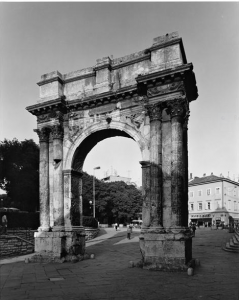The city of Pula, Croatia has a long history which hearkens back to antiquity. The Istrian peninsula was conquered by the Romans in 177 BC and the town was claimed as a Roman colony. Pula became an important Roman port city and during the civil war of 42 BC, the town was destroyed. It was rebuilt at the request of Emperor Octavian’s daughter. Some of the remaining classical monuments are the Pula Arena, a great amphitheater constructed between 27 BC- 68 AD. Once a fortified city, some of the ancient fortifications still remain such as the Arch of the Sergii, the Gate of Hercules and the Twin Gates.
After the fall of the Western Empire, Pula fell to the Ostrogoths though later came under the rule of the Byzantine Empire. The Basilica of Saint Maria Formosa was built here during the 6th century. In 1148, the town was claimed by the Venetians and thus came under the power of the Venetian Empire.
Important monuments, architecture in Pula:
- The Pula Arena (Amphitheater)
- Arch of the Sergii
- Gate of Hercules
- Basilica of Saint Maria Formosa
- Temple of Augustus
- Augustan Forum
- Cathedral of the Assumption of the Blessed Virgin Mary
- Church of St. Francis
- Archaeological Museum of Istria
The Pula Arena
The Pula Arena is the great amphitheater that was built in the 1st century. It is one of the largest surviving amphitheaters in the world. It is also one of the largest Roman arenas in the world. Despite plans under the Fascist regime during World War II to disassemble the amphitheater and move it to mainland Italy, the Pula Arena is one of the most famous landmarks in Croatia.
I have included a link with information on the Pula Arena. This link is from the website of the Archaeological Museum of Istria, which is a great resource in itself
http://www.ami-pula.hr/hr/dislocirane-zbirke/amfiteatar/amfiteatar/
The Arch of the Sergii
The Arch of the Sergii is a well-preserved triumphal arch dating back to the 1st century. It was built on the forum under the reign of Emperor Augustus.
The Twin Gates
The Twin Gates or the porta gemina, are gates which were once part of the Roman fortifications around the town of Pula. The gates were destroyed at the beginning of the 19th century, though the Twin gates were preserved. Dating from the mid-2nd century, the gates are well-decorated with arches, columns and a decorated frieze.
The Gate of Hercules
The Gate of Hercules includes an inscription which dates back to when the town of Pula was founded. A sculpture of Hercules carved in high relief is present on the arch while Hercules’ club can be found carved on one of the voussoirs. It is close to the remains of the old city wall.
Basilica of Saint Maria Formosa
The Basilica of Saint Maria Formosa is a Byzantine chapel which was built during the 6th century. It is similar to the style of the churches in Ravenna, Italy, with its Greek cross shape. 6th century mosaics can be found on the floors and walls of the chapel, which attract many visitors to the chapel each year. In 1605, the Venetians raided Pula and with them, they took the alabaster columns from the chapel to decorate the facade of Saint Mark’s Basilica in Venice. From Pula, the Venetians brought back much Roman spolia.
Temple of Augustus
The Temple of Roma and Augustus was built in the 1st century under the Emperor Augustus. Today, it is well-preserved.
Cathedral of the Assumption of the Blessed Virgin Mary
Built over the site where the original Christians would worship in the Roman times, the Cathedral of the Assumption of the Blessed Virgin Mary is a 6th century church. Destroyed by Genoese and Venetian raids, it was rebuilt in the 15th century and a Renaissance facade was added in the 16th century. Some 6th century Byzantine floor mosaics still remain, though the majority of the church has been reconstructed.
Church of St. Francis
Built in 1314 in the Romanesque style, there are several Gothic additions such as the rose window on the facade. The double pulpit, which is an unusual aspect of the church, even has a part which extends out onto the street. An adjoining monastery dates back to the 14th century.
Archaeological Museum of Istria
Situated close to the Twin Gates, the Archaeological Museum of Istria was opened in 1949 and holds many artifacts from Roman temples as well as early artifacts from the middle ages.
Bibliography:
Goldstein, Ivo. Croatia: A History, London: Hurst & Company, 1999.
Norwich, John Julius. Croatia: Aspects of Art, Architecture, and Cultural Heritage, London: Frances Lincoln Limited Publishers, 2009.
Tanner, Marcus. Croatia: A Nation Forged in War, New Haven: Yale University Press, 1997.
http://www.ami-pula.hr/hr/dislocirane-zbirke/amfiteatar/amfiteatar/









